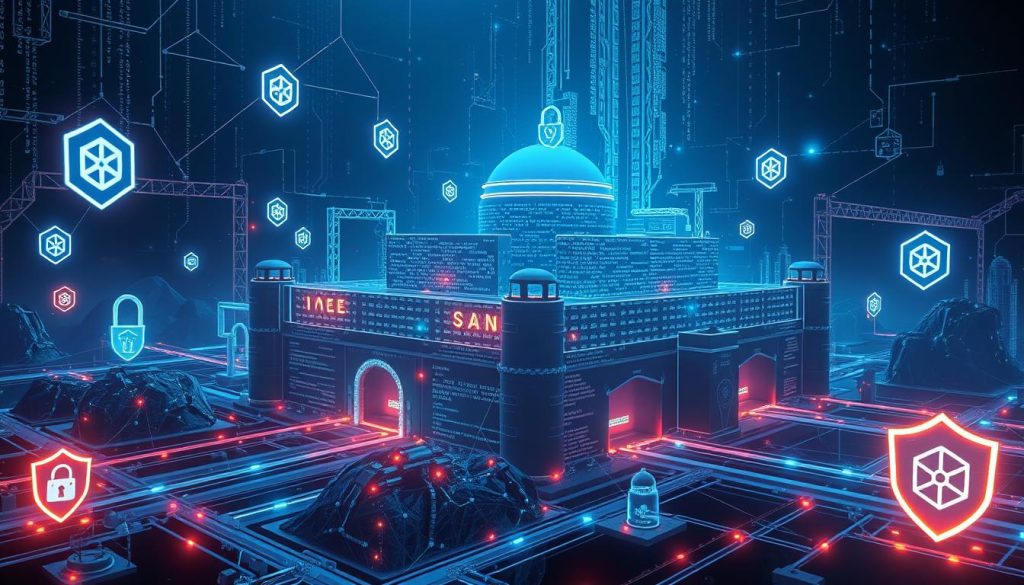Cloud-native security can seem overwhelming. But, the KCSA (Kubernetes and Cloud Native Security Associate Cert Prep) test helps you learn Kubernetes security step by step. This guide will give you the knowledge and skills to protect your containerized environments and cloud-native apps.
Passing the KCSA exam shows you know how to secure your Kubernetes setup. You’ll learn about Kubernetes security and the KCSA test. This guide will help you grow your cloud-native security skills and protect your organization’s important assets.

More and more companies are using Kubernetes and cloud-native tech. This means they need strong security more than ever. It’s key to protect containerized environments and keep cloud-native apps safe.
Containers are the heart of Kubernetes, but they bring their own security issues. You must manage the container life cycle and set up rbac controls and network policies. Using admission controllers and keeping a strong security context is crucial for a solid security base.
Cloud-native apps are complex and dynamic, which adds to their security needs. It’s vital to protect the secure software supply chain and keep a tight cloud security posture management. Using infrastructure as code helps deploy secure setups quickly and reduces risk.
| Security Aspect | Key Considerations |
|---|---|
| Containerized Environments |
|
| Cloud-Native Applications |
|
Getting ready for the Kubernetes and Cloud Native Security Associate (KCSA) test means knowing the key security steps and best ways to manage containers. We’ll look at the main skills tested in the KCSA exam. This will help you pass the test and boost your cloud-native security skills.
The KCSA exam focuses on role-based access control (RBAC). You’ll learn how to set up detailed access rules. This ensures users and workloads can only do what they need to. Knowing RBAC helps stop Kubernetes vulnerabilities and keeps sensitive data safe.
The exam also talks about network policies and admission controllers. You’ll see how to use these tools to manage traffic in your Kubernetes cluster. This helps follow cloud security best practices. With this knowledge, you can make secure Kubernetes deployments for your cloud-native applications.
Threat modeling is a big part of the KCSA test. You’ll learn to spot and deal with threats to your Kubernetes setup. This skill lets you set up strong cloud-native application security and keep your containers safe.
Finally, the KCSA exam looks at Kubernetes security policies. These are key for keeping your cloud-native setups safe and following rules. Knowing how to make and enforce these policies helps protect your important assets.
Learning these main topics and skills will not only help you pass the KCSA test. It also prepares you to improve the cloud-native security of your Kubernetes setup. Take this chance to grow your skills and become a respected Kubernetes security expert.
In the world of Kubernetes, strong security is key. It needs a mix of role-based access control (RBAC), network policies, and admission controllers. These tools help create a zero trust security model and lower risks in cloud-native apps.
RBAC is vital for managing access in a Kubernetes cluster. It lets admins set up permissions for users, groups, or service accounts. This way, everyone gets the right access to do their job. RBAC helps follow the least privilege rule and makes Kubernetes more secure.
Network policies and admission controllers are key to securing Kubernetes clusters. Network policies set rules for pod and service communication. Admission controllers check and enforce security settings before resources are added. They help keep the cluster secure and in line with security policies.
Using service mesh tools like Istio and Linkerd boosts Kubernetes security. These open-source tools offer advanced security contexts and secure deployments. They help implement a full zero trust security model and work well with rbac and network policies.
| Security Control | Description | Key Benefits |
|---|---|---|
| RBAC | Role-based access control to manage permissions | Enforces least privilege, enhances security hardening |
| Network Policies | Defines rules for network traffic between pods and services | Secures communication, enables security monitoring and logging |
| Admission Controllers | Validate and enforce security configurations before deployment | Ensures secure deployments, aligns with organizational policies |
| Service Mesh | Provides advanced security features (e.g., Istio, Linkerd) | Enhances zero trust security model, integrates with RBAC and network policies |
Passing the KCSA exam shows you’re a pro at keeping Kubernetes and cloud-native environments safe. This certification proves you know how to set up strong security measures. It also shows you can reduce risks and keep your apps safe.
Going through the KCSA test has given you a solid grasp of cloud-native security. You’re now ready to face the security challenges in Kubernetes. Your skills in managing access, network policies, and admission controllers will help you keep your software supply chain safe.
As you move forward in your Kubernetes security journey, always keep learning. Stay up-to-date with new trends, vulnerabilities, and standards. With your KCSA certification, you’ll be a key player in keeping your organization’s Kubernetes and cloud-native systems secure.